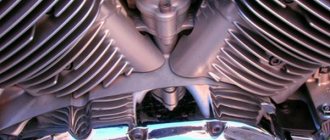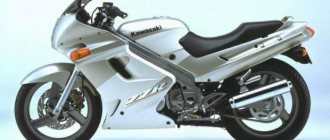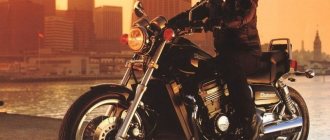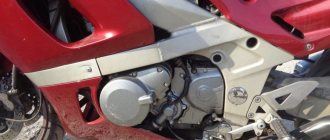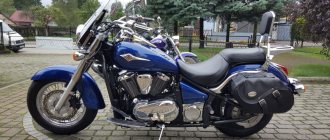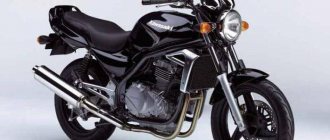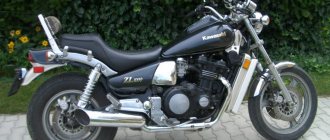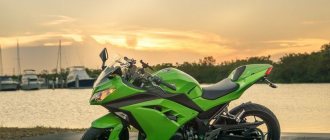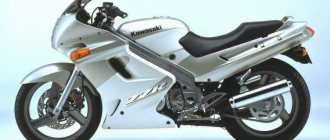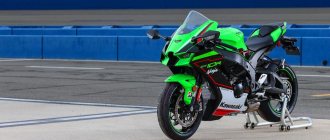- motorcycle model, Kawasaki brand,
The Kawasaki Z800 naked model was first presented at Intermot in 2012 as a successor to the Kawasaki Z750. The motorcycle was available in the European, Oceanian and Southeast Asian markets, and production was moved to Thailand.
The basis was taken from the updated engine from the Z750 with a volume increased to 806 cm³, an increased compression ratio (up to 11.9) and a new Mikuni injection system (instead of Keihin). As a result, the engine began to produce up to 113 hp. power and up to 83 Nm of torque. Maximum performance - from 8000 to 10000 rpm.
The main changes compared to the previous model affected the design of the motorcycle itself, the exhaust and the dashboard. On the technical side, in addition to the engine, the model received the following changes:
Brakes. The diameter of the discs increases to 310 mm, and the calipers become 4-piston.
Suspension. The rear suspension is preload and rebound adjustable.
Fuel tank. The capacity is reduced from 18.5 to 17.0 liters.
Generator. The power increases to 30A (instead of 24A).
Main versions of Kawasaki Z800:
Kawasaki Z800 - regular version (numbers ZR800A, ZR800B - with ABS).
Kawasaki Z800e - version with reduced power (numbers ZR800C, ZR800D - with ABS). Features a limited power of 95 hp. and 76 Nm of torque, non-adjustable fork and monoshock absorber adjustable only by preload.
2016 was the last year of production of the model, after which it left the market. A successor, the Kawasaki Z900, would be introduced in 2021.
Engine
The engine type is in-line, four-stroke, two-cylinder. Its working volume is 773 cm³. It is capable of delivering peak torque of 60 Nm at 2500 rpm. The maximum power at 6500 rpm is 48 hp.
This allows the Kawasaki W800 to have a top speed of 171 km/h. The motorcycle accelerates to 100 km/h in 6.3 seconds. These are quite good indicators for a retro classic. The engine will delight not only class connoisseurs with speed and traction, but also many fans of cruisers or naked bikes.
Test drive KawasakiKawasaki Z 800
When the naked motorcycle boom began in earnest in the 90s, Kawasaki pulled out a long-standing idea to create a brutal naked motorcycle. The competitive Hornets, Fazers and Bandits were a big bone in the throat for the “greens”.
The bike with the name ZR7, falling under this classification, which at that time “plugged” the corresponding “hole” in the Kawasaki lineup, had an outdated air four and was not able to keep up with more technically advanced competitors. And only in 2004, a company from Akasi developed a new model with the Z750 index from scratch, intended for the very demanding European market.
Hitting the spot
Buyers quickly tried out the motorcycle and sales of the Z750, as they say, “shot.” Moreover, this “shot” hit the exact center of the target of consumer demand and literally scattered other competitors to the sides.
Then 2007 came and the “green bestseller”, having received a more dynamic and aggressive design, continued to climb to the top of sales statistics. The total volume of sold Z750 of both generations amounted to a total of 160,000 copies. None of the competing models in this segment even come close to these figures.
The current year 2013 was the debut year for the third generation of Zeta, this time with an engine with a displacement increased to 800 cubic centimeters. Will the new model be a worthy successor to its outstanding predecessors?
It's no secret that motorcycles in this segment are bought with their eyes. This streetbike has a dynamic and aggressive look, which makes it stand out in a crowd of other two-wheeled “buzzers” without fairings. And this is one of the most important criteria for buyer selection, as evidenced not only by marketers’ research, but also by the opinions of many riders.
Kawasaki realized long ago that if they wanted to stay on top of demand, they needed to continue the philosophy of the first generation "Z". Of course, there were comments from various “summer residents” who called the Kawasaki style too aggressive. But in contrast to this, there is a much more significant opinion that Japanese bikes are boring and indistinguishable from each other - something that the “greens” are actively fighting against.
Meanwhile, in real life the Z800 looks “like a million dollars,” although they don’t say that about motorcycles. Compact, well-built, with dynamic, sharp body kit lines. The headlight looks like Spiderman's eyes, and the stylized letter "Z" is visible in the decoration of many parts. It’s tempting to turn the key in the ignition and rush like a whirlwind through the evening urban jungle!
Digital Anomaly
When you get behind the wheel of a Z800, mixed feelings arise in your head... as if you already knew it all. The ergonomics of the motorcycle are built according to the canons of the good old Japanese school, where everything should be exactly where you expect it to be. Particular attention is paid to the fit, which ensures good contact with the bike and, at the same time, facilitates long trips - this is achieved by the special shape of the tank and the “waist” of the motorcycle, as well as the relatively high and wide handlebars.
You will be pleasantly surprised by the extensive range of indicators displayed on the futuristic and slightly strange dashboard. In addition to the standard set of speed-rpm-temperature, the Z800's instrumentation provides the rider with information about average and instantaneous fuel consumption, as well as the distance that can be covered on the remaining fuel. The central part of the dashboard, which looks like it was lifted from a Star Wars fighter, is occupied by a columnar LCD tachometer. As the speed increases, the stripes become wider, which increases their readability. In theory. Personally, I prefer the classic round dial with the red arrow.
A significant drawback for me was the seat, which is tilted too much towards the tank. Combined with the slippery upholstery, it creates the effect of sliding forward, which is certainly good for aggressive urban maneuvering between rows, but does not contribute to comfort when driving in a straight line.
In addition, the mirrors could be made larger, since the standard ones provide a very limited view. So, the path for functional “improvement” of the new product already exists.
More is better
The new 800cc engine is not just a boring old one. Yes, the cylinder diameter increased from 68.4 mm to 71.0 mm, but in addition, the designers thoroughly redesigned its other parts and systems. For example, valve diameters have also been increased, timing elements have become lighter, the lubrication system has increased performance, and the injection system has become more accurate. The total weight savings compared to the 750 cc predecessor engine was approximately a kilogram.
But the most important thing is that this engine has more torque and power throughout the entire rev range than its predecessor. 83 Nm at 8000 rpm and 111 hp. at 10200 rpm – quite enough for dynamic driving. It is worth noting that the designers did not raise the power curve excessively (although they could have – the engine potential allows it), thereby ensuring excellent traction throughout the entire rev range.
In addition to the above, the engineers decided to use a higher final drive ratio (45-tooth rear sprocket instead of 43-tooth), which makes the 800cc bike even more dynamic. The gearbox and clutch remained virtually unchanged, since they were already, as they say, “to the hilt” tuned back on the Z750.
Rigid moral basis
In addition to the many changes to the engine, the chassis has also changed. First of all, the steel frame has been widened. The engine is included in the power structure, and its additional rigidity is provided by the traditional Zeta struts that encircle the engine. The rear swingarm has been lengthened by 12 mm (from 560 to 572) and is paired with a monoshock absorber, in which the designers did a little magic on the valve system. For personal tuning, you can play with the spring preload and rebound damping (unfortunately, the simplified version of the Z800E has a non-adjustable fork, and the shock can only be adjusted by spring preload).
Take a look at the brakes. Nissin's new 4-piston calipers may be far from the standard of sports braking systems, but they can quickly settle the bike when necessary, all the while remaining under full control of the rider. Well, the anti-lock braking system installed in the base makes braking as safe as possible. The diameter of the petal brake discs has been increased from 300 to 310 mm, which has a positive effect on the performance of the system.
The most important
What do we get in the bottom line? Probably an unforgettable and vivid driving experience. The alphanumeric combination "Z800" should now become synonymous with pure pleasure. Zetas have always driven very well, but the 800 has set new standards for a positive driving experience. The engine is great! It provides a light and compact motorcycle with excellent dynamics, as well as excellent information content. The response to throttling is as precise as possible, the motor spins up almost instantly. There is a charm to shortened gears, which I found while making my way through the crowded streets of Monte Carlo and Nice. The new Zet allows you to drive in sixth gear at a speed of 60 km/h, and then just add gas and quickly accelerate to a maximum of 230 km/h. On the other hand, on the highway, short gears make the engine feel like it's lacking. Therefore, I firmly believe that many future Z800 owners will install a rear sprocket that is two teeth smaller. In any case, something always has to be sacrificed.
Kawasaki surprised me with how easy it is to control. On Internet forums, the Z800 has already been accused of being heavier than its competitors, but... I'll tell you what. Take “Z” and multiply it by 160 thousand happy owners of the previous generation of this streetfighter. Apparently, they are not bothered by the weight... After a few days of riding, a few extra kilos on the motorcycle will no longer matter to you.
This “800” is great on mountain serpentines, where the motorcycle requires precise handling and good acceleration from the bottom. The wide steering wheel not only fits comfortably under your hands, but also makes driving easier, allowing you to quickly and effortlessly change course at low speeds.
Factory suspension calibrations are as close to ideal as possible. I am sure that 99% of future Z800 owners will not have a desire to tweak or reconfigure anything, because asphalt unevenness is handled very effectively, and the contact patch is as large as possible. The bike is also stable at high speeds and “holds” its trajectory in high-speed turns without nervousness.
I've been repeatedly asked to comment on the practical differences between the new model and the Z750. Subjectively, I felt progress in every area. The new bike is more dynamic, comfortable, beautiful and at the same time balanced. Our Z800 tester was shod with brand new Dunlop D214s, which provide amazing grip even on poor quality wet pavement. To make a fair comparison of the two models, we would have to put the same tires on them. Unfortunately, we did not have such an opportunity. As for comparison with direct competitors, I dare to please you - in the spring we will conduct a big test in order to find out the advantages of this or that bike.
In addition, the Kawasaki Z800 is comfortable and practical in everyday driving, as it uses gasoline economically. Average fuel consumption is about 6 liters per 100 kilometers.
The manufacturer offers many optional bells and whistles. For example, a motorcycle can be equipped with a windshield, high handlebars, saddlebags and heated handlebars, turning it into a full-fledged tourist. In short, the bike allows you to transform itself to suit your goals and objectives.
Modifications
In addition to the regular Z800, there is also the Z800E - it is simpler and cheaper. Some clarification is required here. Modification “E” is a response to the realities of the European market (remember the legislative and tax threshold for engine power at around 100 hp for many EU countries). That’s why a version with “stifled” up to 95 hp appeared. engine, simpler suspension and 2-piston front brake calipers instead of 4-piston.
Forecast – optima
The purpose of releasing a new product was to gain its appreciation among the widest possible audience of buyers. To come to this conclusion, you do not need to be a lecturer in the department of logic at Oxford or Cambridge. There are a lot of obvious reasons for this. The motorcycle looks very good, and as we know, it is the type of bike that people buy with their eyes. The new Kawasaki Z800 is a motorcycle built for success.
All Z800 systems are balanced and work perfectly together. In addition, the “greens” put such a nice price tag on their 800 that competitors, at a minimum, should prepare for an unequal battle for customers’ wallets. Do you see another leadership candidate around? Me not.
Text: Mariusz Łowicki
Photo: provided by the author
Adaptation: Sergey Kuznetsov
Dimensions and weight
The model reaches 2190 mm in length. This makes it quite large in relation to motorcycles in general and average in its class. The width of the bike is 790 mm, and the height of the model is 1075 mm. The wheelbase dimensions reach 1485 mm, and the seat height is 790 mm.
The curb weight of the motorcycle is 216 kg. Its gas tank capacity is 14 liters, which is average for bikes in general. The Kawasaki B800 consumes 5-5.5 liters per 100 km of road, which, considering its dimensions, is a very good indicator.
Brief history of the model
2013 - start of production and sales of the model. Model: Kawasaki Z800 + ABS (Asia, Europe, Oceania). Factory designation: ZR800ADS + ZR800BDS; ZR800CDS + ZR800DDS (e-version: 95 hp & 76 Nm; non-adjustable suspension).
2014 - no significant changes. Model: Kawasaki Z800 + ABS (Asia, Europe, Oceania). Factory designation: ZR800AEF + ZR800BEF; ZR800CEF + ZR800DEF (e-version: 95 hp & 76 Nm; non-adjustable suspension).
2015 - no significant changes. Model: Kawasaki Z800 + ABS (Asia, Europe, Oceania). Factory designation: ZR800AFF + ZR800BFF; ZR800CFF + ZR800DFF (e-version: 95 hp & 76 Nm; non-adjustable suspension).
2016 is the last year of production. Model: Kawasaki Z800 + ABS (Asia, Europe, Oceania). Factory designation: ZR800AGF + ZR800BGF; ZR800CGF + ZR800DGF (e-version: 95 hp & 76 Nm; non-adjustable suspension).
Chassis and brakes
The frame of the bike is steel and tubular. It has a classic design, reminiscent of those old motorcycles that used to be found in large numbers on European streets and country roads. Of course, the wheels are spoked.
The steering wheel is comfortable and its size corresponds to the standards accepted for retro classic bikes. Yes, and it looks quite stylish, but, like everything else on this motorcycle, it’s not flashy. Models of this class are simply not supposed to be full of bright colors, otherwise something in their classic, dignified appearance will be lost and slip away.
The rear suspension of the Kawasaki B800 is pendulum and equipped with two shock absorbers. Its stroke is 106 mm. The front suspension is represented by a 39 mm telescopic fork with a travel of 130 mm.
The rear brake is a 160 mm drum, while the front brake is a 300 mm disc with a two-piston caliper. These brakes are enough to regulate the speed of this average-powered motorcycle.

